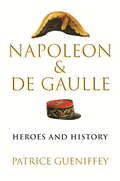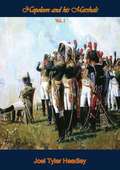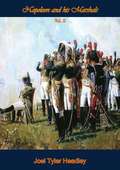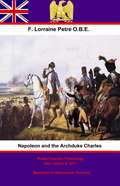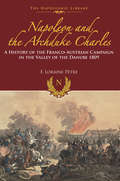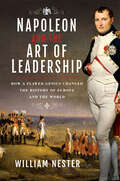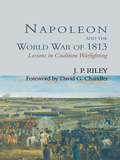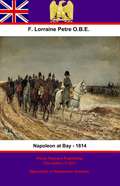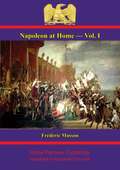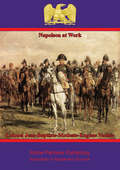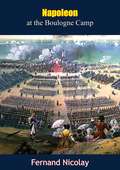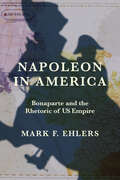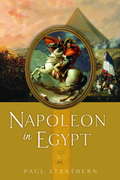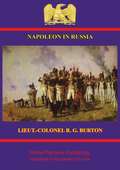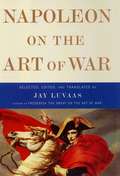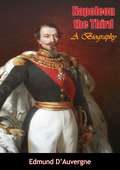- Table View
- List View
Napoleon and de Gaulle: Heroes and History
by Patrice GueniffeyOne of France’s most famous historians compares two exemplars of political and military leadership to make the unfashionable case that individuals, for better and worse, matter in history. Historians have taught us that the past is not just a tale of heroes and wars. The anonymous millions matter and are active agents of change. But in democratizing history, we have lost track of the outsized role that individual will and charisma can play in shaping the world, especially in moments of extreme tumult. Patrice Gueniffey provides a compelling reminder in this powerful dual biography of two transformative leaders, Napoleon Bonaparte and Charles de Gaulle. Both became national figures at times of crisis and war. They were hailed as saviors and were eager to embrace the label. They were also animated by quests for personal and national greatness, by the desire to raise France above itself and lead it on a mission to enlighten the world. Both united an embattled nation, returned it to dignity, and left a permanent political legacy—in Napoleon’s case, a form of administration and a body of civil law; in de Gaulle’s case, new political institutions. Gueniffey compares Napoleon’s and de Gaulle’s journeys to power; their methods; their ideas and writings, notably about war; and their postmortem reputations. He also contrasts their weaknesses: Napoleon’s limitless ambitions and appetite for war and de Gaulle’s capacity for cruelty, manifested most clearly in Algeria. They were men of genuine talent and achievement, with flaws almost as pronounced as their strengths. As many nations, not least France, struggle to find their soul in a rapidly changing world, Gueniffey shows us what a difference an extraordinary leader can make.
Napoleon and his Family: The Story of a Corsican Clan, Vol I (Napoleon and his Family: The Story of a Corsican Clan #1)
by Walter GeerFirst published in 1927, this book represents Volume I in a series of three volumes. It covers the Napoleonic period of 1769 through to 1809: from his beginnings in Corsica to battle in Spain.“It is impossible to understand fully the drama of the life of Napoleon without taking into consideration two factors, practically ignored by historians, which had a decisive bearing upon his career: his physical heritage, and the influence of his family.“The fame of Napoleon has so overshadowed that of his brothers and sisters that their influence on his career has generally been overlooked. Without disregarding the other cause, which was largely beyond his control, it may be said that the downfall of Napoleon was mainly due to the members of his family, whom he had raised so high, who by their shortcomings and their transgressions became the agents of his decline.“We propose to set forth in these pages the part for which the Family was responsible in the events which brought about the crumbling of the highest fortune that the world has ever seen upraised.“In this drama of Napoleon and His Family there are over twenty persons who take the subordinate roles, and occupy the stage beside the principal actor, but the character of Napoleon dominates the entire play.This, then, is not a life of Napoleon: not a history of his campaigns: not a record of his civil administration—it is only the story of the Family, as it influenced his designs, his acts, and his destiny.”
Napoleon and his Family: The Story of a Corsican Clan, Vol II (Napoleon and his Family: The Story of a Corsican Clan #2)
by Walter GeerFirst published in 1928, this book represents Volume II in a series of three volumes. It covers the Napoleonic period of 1809-1813, following on from Napoleon’s return from Spain and ending with the French Army’s offensive on Russia.“It is impossible to understand fully the drama of the life of Napoleon without taking into consideration two factors, practically ignored by historians, which had a decisive bearing upon his career: his physical heritage, and the influence of his family.“The fame of Napoleon has so overshadowed that of his brothers and sisters that their influence on his career has generally been overlooked. Without disregarding the other cause, which was largely beyond his control, it may be said that the downfall of Napoleon was mainly due to the members of his family, whom he had raised so high, who by their shortcomings and their transgressions became the agents of his decline.“We propose to set forth in these pages the part for which the Family was responsible in the events which brought about the crumbling of the highest fortune that the world has ever seen upraised.“In this drama of Napoleon and His Family there are over twenty persons who take the subordinate roles, and occupy the stage beside the principal actor, but the character of Napoleon dominates the entire play.This, then, is not a life of Napoleon: not a history of his campaigns: not a record of his civil administration—it is only the story of the Family, as it influenced his designs, his acts, and his destiny.”
Napoleon and his Family: The Story of a Corsican Clan, Vol III (Napoleon and his Family: The Story of a Corsican Clan #3)
by Walter GeerFirst published in 1929, this book represents Volume III in a series of three volumes. It covers the Napoleonic period of 1813-1821, following on from Napoleon’s return from the Campaign of Russia and ending with his exile in St. Helena.“It is impossible to understand fully the drama of the life of Napoleon without taking into consideration two factors, practically ignored by historians, which had a decisive bearing upon his career: his physical heritage, and the influence of his family.“The fame of Napoleon has so overshadowed that of his brothers and sisters that their influence on his career has generally been overlooked. Without disregarding the other cause, which was largely beyond his control, it may be said that the downfall of Napoleon was mainly due to the members of his family, whom he had raised so high, who by their shortcomings and their transgressions became the agents of his decline.“We propose to set forth in these pages the part for which the Family was responsible in the events which brought about the crumbling of the highest fortune that the world has ever seen upraised.“In this drama of Napoleon and His Family there are over twenty persons who take the subordinate roles, and occupy the stage beside the principal actor, but the character of Napoleon dominates the entire play.This, then, is not a life of Napoleon: not a history of his campaigns: not a record of his civil administration—it is only the story of the Family, as it influenced his designs, his acts, and his destiny.”
Napoleon and his Marshals - Vol I (Napoleon and his Marshals #1)
by Pickle Partners Publishing Joel Tyler HeadleyThis ebook is purpose built and is proof-read and re-type set from the original to provide an outstanding experience of reflowing text for an ebook reader. J. T. Headley was born at the very end of the convulsive period of the French revolution and Napoleonic Wars that followed, and wrote a number of volumes on the French army and its leadership of the period. An admirer of the equality and liberty that Napoleon and the Napoleonic Myth expounded, Headley takes an interesting and entertaining view of Napoleon and his Marshals. The glittering array of military talent available to Napoleon, was formed by the upsurge in manpower revolutionary levée en masse and the egalitarian principals. Whilst not an absolute meritocracy, a great number of Generals and indeed Marshals came from humble backgrounds. In this volume, the author charts the careers of Napoleon, Marshals Murat, Lefebvre, Massena, Marmont, Victor, Brune, Oudinot, Bessières, Jourdan, Bernadotte, Suchet, Poniatowski, Grouchy and Ney Text taken, whole and complete, from the 1846 edition published in New York by Baker and Scribner. Original 316 pages.
Napoleon and his Marshals - Vol II (Napoleon and his Marshals #2)
by Pickle Partners Publishing Joel Tyler HeadleyThis ebook is purpose built and is proof-read and re-type set from the original to provide an outstanding experience of reflowing text for an ebook reader. J. T. Headley was born at the very end of the convulsive period of the French revolution and Napoleonic Wars that followed, and wrote a number of volumes on the French army and its leadership of the period. An admirer of the equality and liberty that Napoleon and the Napoleonic Myth expounded, Headley takes an interesting and entertaining view of Napoleon and his Marshals. The glittering array of military talent available to Napoleon, was formed by the upsurge in manpower revolutionary levée en masse and the egalitarian principals. Whilst not an absolute meritocracy, a great number of Generals and indeed Marshals came from humble backgrounds. In this volume, the author charts the careers of Napoleon, Marshals Murat, Lefebvre, Massena, Marmont, Victor, Brune, Oudinot, Bessières, Jourdan, Bernadotte, Suchet, Poniatowski, Grouchy and Ney. Text taken, whole and complete, from the 1846 edition published in New York by Baker and Scribner. Original 316 pages.
Napoleon and the Archduke Charles
by Pickle Partners Publishing Francis Loraine Petre O.B.EThis ebook is purpose built and is proof-read and re-type set from the original to provide an outstanding experience of reflowing text for an ebook reader. "The campaign which forms the subject of this volume is one which has received scant notice in England, and has been a good deal misunderstood. The misunderstanding has been mainly due to Napoleon's successful misrepresentation of the earlier part as one of his greatest and most successful efforts." So begins Petre's excellent study of the 1809 campaign in Germany, the most concise study of one of the most interesting of Napoleon's campaigns. The peace of Tilsit in 1807 was the Apogee of Napoleon's reign, he had subdued all of his continental enemies; Prussia a broken wreck after Jena-Auerstädt, Austria smashed at Austerlitz, Russia humbled after Friedland. However the new allies of the French smarted from the reduction of territory, prestige and glory, they were also being squeezed by the constraints of commerce embodied by the Continental system whereby Britain and her products were meant to be kept out of mainland Europe. They looked only for a sufficient time to re-gather their forces, bide their time and strike to take back what was formerly theirs, as the peace creaked and groaned under the pressure, Napoleon decided to dethrone the Spanish Bourbons in 1808. The Peninsular war would grow into a painful "ulcer" for the French and after set backs such as the disaster of Baylen, where an entire French army corps surrendered to the Spanish, and Vimiero where the French were kicked out of Portugal, the continent took heart and prepared to strike at Napoleon. The Austrians were to take up the challenge in 1809, under the leadership of the Archduke Charles, the Emperor's younger brother. He had spent some time modernising the army after the defeats of 1805, and although advising against the timing of the war he stood ready to take charge. Napoleon gathered his forces quickly, boosted in numbers by German allies, and advised his lieutenants in the theatre what to prepare. However his orders were misinterpreted and when put into action the French forces were scattered and in danger of being overwhelmed piece-meal. However Napoleon managed to salvage the situation, and despite a growing number of mistakes, and some sterling fighting on the part of Davout, pushed the advancing Austrians from Bavaria. The road to Vienna was thus opened for him, but he would have to first cross the Danube and pass to the Marchfeld to take on his most able continental opponent. The battles of Aspern-Essling and Wagram were to follow, leaving Napoleon beaten off the field of battle for the first time in a major engagement, as the decline in his "star" starts. A great read, by a master historian. Author - Francis Loraine Petre OBE - (1852-1925)
Napoleon and the Archduke Charles: A History of the Franco-Austrian Campaign in the Valley of the Danube 1809 (The Napoleonic Library)
by F. Lorraine PetreThe Archduke Charles was the most formidable of Napoleons continental foes but only once came into direct conflict with him: this was in the 1809 Franco-Austrian campaign in the Danube Valley.Smarting from Austrias humiliations in 1805, the Archduke launched a surprise attack upon the French whilst Napoleon was occupied in distant Spain. Outnumbered, the French faced disaster but, with typical energy and decisiveness Napoleon arrived just in time. In five days of marching and fighting he repulsed the Austrians at Abensburg and Eckmhl. The road to Vienna was now oPen & he pushed on but he underestimated his enemy, being thrown back by the Archduke Charles as he tried to cross the Danube.Failing to follow up his success, the Archduke hesitated too long and when Napoleon attempted to cross the river a second time, at the Battle of Wagram, he succeeded.F. Loraine Petres penetrating analysis of this pivotal campaign was first published in 1909 on the centenary of the great conflict, to become one of his celebrated series of works on Napoleons wars.
Napoleon and the Art of Leadership: How a Flawed Genius Changed the History of Europe and the World
by William NesterThis deep dive into the mind of the complex, controversial political and military leader is “a great addition to the field of Napoleonics” (Journal of Military History).No historical figure has provoked more controversy than Napoleon Bonaparte. Was he an enlightened ruler or brutal tyrant? An insatiable warmonger or a defender of France against the aggression of the other great powers? Kind or cruel, farsighted or blinkered, a sophisticate or a philistine, a builder or a destroyer? Napoleon was at once all that his partisans laud, his enemies condemn, and much more. He remains fascinating, because he so dramatically changed the course of history and had such a complex, paradoxical character.One thing is certain: If the art of leadership is about getting what one wants, then Napoleon was among history’s greatest masters. He understood and asserted the dynamic relationship among military, economic, diplomatic, technological, cultural, psychological—and thus political—power. War was the medium through which he was able to demonstrate his innate skills, leading his armies to victories across Europe. He overthrew France’s corrupt republican government in a coup, then asserted near dictatorial powers. Those powers were then wielded with great dexterity in transforming France from feudalism to modernity with a new law code, canals, roads, ports, schools, factories, national bank, currency, and standard weights and measures. With those successes, he convinced the Senate to proclaim him France’s emperor and even got the pope to preside over his coronation. He reorganized swaths of Europe into new states and placed his brothers and sisters on the thrones.This is Napoleon as has never been seen before. No previous book has explored his seething labyrinth of a mind more deeply and broadly or revealed more of its complex, provocative, and paradoxical dimensions. Napoleon has never before spoken so thoroughly about his life and times through the pages of a book, nor has an author so deftly examined the veracity or mendacity of his words. Within are dimensions of Napoleon that may charm, appall, or perplex, many buried for two centuries and brought to light for the first time. Napoleon and the Art of Leadership is a psychologically penetrating study of the man who had such a profound effect on the world around him that the entire era still bears his name.
Napoleon and the Fair Sex
by Anon. Frédéric MassonFrédéric Masson stands as one of the foremost historians that France has ever produced. His specialist subject was the era of Napoleon, and few men have written such brilliant and penetrating studies of the Emperor. In this volume, translated from his book 'Napoléon et les femmes', Masson charts the Emperor's amorous adventures throughout his life. It is a wonder that Napoleon had any time to engage in the domination of Europe, given his propensity to ladies; he was twice married, cuckolded numerous times, frequent lover of opera singers and actresses, step-father to two children, father to his heir, the Duke of Reichstadt, and the father of at least two illegitimate children. This work masterfully brings Napoleon's often tumultuous relationships with the women in his life with full colour and detail.Author -- Masson, Frédéric, 1847-1923.Translator -- Anon.Text taken, whole and complete, from the edition published in London : W. Heinemann, 1896 Original Page Count - 320 pages.Illustrations -- 10 portraits.
Napoleon and the Struggle for Germany: The Franco-Prussian War of 1813
by Michael V. LeggiereThis is the first comprehensive history of the campaign that determined control of Germany following Napoleon's catastrophic defeat in Russia. Michael V. Leggiere reveals how, in the spring of 1813, Prussia, the weakest of the great powers, led the struggle against Napoleon as a war of national liberation. Using German, French, British, Russian, Austrian and Swedish sources, he provides a panoramic history that covers the full sweep of the battle for Germany from the mobilization of the belligerents, strategy, and operations to coalition warfare, diplomacy, and civil-military relations. He shows how Russian war weariness conflicted with Prussian impetuosity, resulting in the crisis that almost ended the Sixth Coalition in early June. In a single campaign, Napoleon drove the Russo-Prussian army from the banks of the Saale to the banks of the Oder. The Russo-Prussian alliance was perilously close to imploding, only to be saved at the eleventh-hour by an armistice.
Napoleon and the Struggle for Germany: The Franco-Prussian War of 1813
by Michael V. LeggiereThis is the first comprehensive history of the campaign that determined control of Germany following Napoleon's catastrophic defeat in Russia. Michael V. Leggiere reveals how, in the spring of 1813, Prussia, the weakest of the great powers, led the struggle against Napoleon as a war of national liberation. Using German, French, British, Russian, Austrian and Swedish sources, he provides a panoramic history that covers the full sweep of the battle for Germany from the mobilization of the belligerents, strategy, and operations to coalition warfare, diplomacy, and civil-military relations. He shows how Russian war weariness conflicted with Prussian impetuosity, resulting in the crisis that almost ended the Sixth Coalition in early June. In a single campaign, Napoleon drove the Russo-Prussian army from the banks of the Saale to the banks of the Oder. The Russo-Prussian alliance was perilously close to imploding, only to be saved at the eleventh-hour by an armistice.
Napoleon and the World War of 1813: Lessons in Coalition Warfighting
by J.P. RileyThis analysis of the world war between Napoleon and the 6th coalition in 1813 covers operations in Europe, Spain and North America. It examines the differences between alliances and coalitions, comparing the long-term international relationships in alliances and the short-term union of coalitions.
Napoleon at Bay – 1814
by Pickle Partners Publishing Francis Loraine Petre O.B.EThis ebook is purpose built and is proof-read and re-type set from the original to provide an outstanding experience of reflowing text for an ebook reader. Following on from the Author's "Napoleon's Last Campaign in Germany", Petre's closely researched and well argued account of the 1814 campaign, which would see some of the finest strategical manoeuvres of Napoleon's entire career. As the wreck of the last Grande Armée created in 1813, retreated home from Germany to France it was a pale shadow of its former glory. Marched into the ground as Napoleon struggled to pin down his enemies, and then beaten at Leipzig in the "battle of Nations" as faced by overwhelming weight of men, cavalry and cannon. They had shown their mettle at Hanau by brutally brushing aside the Bavarians who sought to bar their way across the Rhine, but there were now only some 70,000 to 80,000 men still with the colours. The men garrisoning cities and fortresses such as Danzig were lost to the great General, and his enemies implacably approached the soil of France. With such an outlook, what then occurred was perhaps Napoleon's finest hour, he rallied every last reserve, he could from veterans scraped from the Spanish frontier, or barely adult conscripts. He would then embark on the "Six Days Campaign", in which he beat the army of Silesia under Blücher, four times in six days. The manoeuvres that led to the battles of Champaubert, Montmirail, Château-Thierry and Vauchamps, are justly celebrated. The tragic dénouement which he and his victorious veterans would suffer, despite all of their hard fought victories would still be the ignominy of defeat as Napoleon's Generals and Marshals shed their allegiance to him to save France. Author - Francis Loraine Petre OBE - (1852-1925) Text taken, whole and complete, from the edition published in 1904, London, by John Lane, The Bodley Head. Original - 222 pages. MAPS - due to their size have not been included [4 A3] Linked TOC
Napoleon at Home — Vol. I (Napoleon at Home #1)
by Anon. Frédéric MassonMuch has been written about the life of Napoleon, whose actions dominated the beginning of the Nineteenth century; his campaigns have been charted in great detail as have his political manoeuvres; however, his life during his few quiet hours remained less well known - until the renowned Frédéric Masson cast his expert eye on them.Ranging from the court audiences reminiscent of the Ancien Régime kings such as Louis XIV to simple days at home with his extended family, the author draws out the detail of the household of the Emperor. The rooms and daily routines are juxtaposed with the celebrated events of the Imperial calendar to great effect, the mundane and the grand living side by side. As time passed and Napoleon gained more wealth and power, so the routines changed and the splendour increased. The author goes into every facet without losing the reader's interest. An astounding and intimate portrait of Napoleon, the man and the Emperor.Author -- Masson, Frédéric, 1847-1923.Translator -- James E. Matthew.Text taken, whole and complete, from the edition published in London : H. Grevel and Co. and Philadelphia J. B. Lipincott, 1894 Original Page Count - li and 198 pages.Illustrations -- 12 illustrations.
Napoleon at Home — Vol. II (Napoleon at Home #2)
by Anon. Frédéric MassonMuch has been written about the life of Napoleon, whose actions dominated the beginning of the Nineteenth century; his campaigns have been charted in great detail as have his political manoeuvres; however, his life during his few quiet hours remained less well known - until the renowned Frédéric Masson cast his expert eye on them.Ranging from the court audiences reminiscent of the Ancien Régime kings such as Louis XIV to simple days at home with his extended family, the author draws out the detail of the household of the Emperor. The rooms and daily routines are juxtaposed with the celebrated events of the Imperial calendar to great effect, the mundane and the grand living side by side. As time passed and Napoleon gained more wealth and power, so the routines changed and the splendour increased. The author goes into every facet without losing the reader's interest. An astounding and intimate portrait of Napoleon, the man and the Emperor.Author -- Masson, Frédéric, 1847-1923.Translator -- James E. Matthew.Text taken, whole and complete, from the edition published in London : H. Grevel and Co. and Philadelphia J. B. Lipincott, 1894 Original Page Count - 248 pages.Illustrations -- 12 illustrations.
Napoleon at Work
by Colonel Jean-Baptiste-Modeste-Eugène VachéeThis ebook is purpose built and is proof-read and re-type set from the original to provide an outstanding experience of reflowing text for an ebook reader. At the turn of the 20th Century, the historical section of the French General Staff began to produce some of the most valuable and detailed studies of the Napoleonic period, and particularly Napoleon's method for success in war. This upsurge in French military writing, and particularly of the period of greatest French success, was, not coincidentally, foreshadowed the upcoming hostilities with Germany during which Colonel Vachée was to serve in the French artillery. He wrote "Napoleon en Campagne", of which this book is the English translation, to try to codify the rules of warfare for his contemporary French officers. Using the 1806 Jena campaign (an interesting counter viewpoint to Field Marshal Von der Gotlz's - Jena to Eylau written from the Prussian point of view of the same campaign) as an example of Napoleon's method of victory, Vachée gives a detailed account of the Emperor's closest collaborators: Marshal Berthier, Generals Bacler d'Albe, Bailly de Monthion, Gourgaud, Montholon, Caulaincourt, his secretaries Bourienne, Méneval and Fain et al. He illustrates the methods used to inspire his men from the highest Marshal of the Empire to the lowliest grognard, and the punishments for failure, both on and off the battlefield. An excellent book, useful for the study of command in wartime and the Napoleonic methods in particular. Title - Napoleon at Work Author -- Colonel Jean-Baptiste-Modeste-Eugène Vachée (????-????) Translator and Foreword by - George Frederic William Lees (1872-????) Text taken, whole and complete, from the edition published in 1914, London, by A. and C. Black. Original - xx and 324 pages. Illustrations -- Sketch maps included, larger A3 folding maps cannot be included due to their size.
Napoleon at the Boulogne Camp: (based On Numerous Hitherto Unpublished Documents) - Primary Source Edition
by Fernand Nicolay“THE reasons which induced me to publish the present work are briefly these: My father was a Boulonnais, and owner of the land historically famous for its associations with Bonaparte and Bruix. I have therefore in my possession a number of documents, hitherto unpublished, concerning the Camp of Boulogne.“Besides this, during the many years spent on my father’s property at the Plateau d’Odre, I have had many opportunities of acquiring information and collecting circumstantial evidence on the spot itself, from old men who had seen and talked with Napoleon, and had served under him.“When writing these pages, in full view of the splendid panorama of the Boulogne roadstead, and from the top of the very cliff on which Napoleon and the Commander of the Flotilla had once taken up their quarters, I could not help thinking that the narrative of former events and of memorable incidents would certainly be of psychological interest to the public.“Added to this, it seemed to me that a faithful record of typical details connected with Napoleon’s Camp at Boulogne, might even prove a useful contribution to the military history of that period, in which the extraordinary and fertile activity of Napoleon—seconded by the ardour, so typical, of his soldiers and sailors—had inspired England with fear, and served to organise an incomparable army.”
Napoleon in 100 Objects (In 100 Objects Ser.)
by Gareth Glover“Takes a look at the life of Napoleon Bonaparte through using 100 objects . . . an entertaining method of presenting a biography.” —Battles and Book ReviewsFor almost two decades, Napoleon Bonaparte was the most feared, and revered, man in Europe. At the height of his power, the land under his control stretched from the Baltic to the Mediterranean, and encompassed most of Western Europe.The story of how a young Corsican, who spoke French with a strange accent, became Emperor of the French at the age of just thirty-three is a remarkable one. The many fascinating objects brought together in this book detail not only Napoleon’s meteoric rise to power, but also his art of war and that magnificent fighting force, the Imperial Guard, which grew from a small personal bodyguard to the size of a small army. Some of his great battles, such as Marengo, Austerlitz, Jena and Wagram, are also explored, as is his exile and ultimate defeat at Waterloo. In this engaging and hugely informative book, the author takes us on a journey across Napoleonic Europe to discover the places, people and objects that tell the story of one man’s life. It is a story of one of the most turbulent eras in history, one that, to this day, still bears Bonaparte’s name. But his legacy lives on in the French legal and social systems and he remains as enigmatic a figure today as he did 200 years ago.“An amazing collection of objects that aid our understanding of the man who wanted to rule the world.” —Books Monthly
Napoleon in America: Bonaparte and the Rhetoric of US Empire (The Revolutionary Age)
by Mark F. EhlersHow Napoleon&’s legacy infused American debates over empire in the nineteenth century No individual dominated the early nineteenth century like Napoleon Bonaparte, the titanic figure who came to embody the French Revolution and nearly brought all of Europe to heel. He exerted a cultural influence in his time that few figures in world history have ever attained. As a result, when Americans debated the merits, limits, and administration of their own burgeoning republican empire, they continually invoked Napoleon to make their point. From the presidency of Thomas Jefferson and for decades afterward, the legacy of Napoleon loomed over discussions about the course their country&’s expansion would take. As Mark Ehlers shows, Americans of all persuasions rhetorically enlisted Napoleon to advocate for their competing visions of US imperialism. Whether they admired his method of imperial rule or saw in him a warning against the hubris of imperial overreach, Napoleon&’s image served as an essential cultural touchpoint in the early republic&’s rhetoric of empire—until finally, by the Mexican War, most Americans had come to imagine their republican empire as a worthy successor to Napoleon&’s own.
Napoleon in Egypt: The Greatest Glory
by Paul StrathernIn 1798, Napoleon Bonaparte, only twenty-eight, set sail for Egypt with 335 ships, 40,000 soldiers, and a collection of scholars, artists, and scientists to establish an eastern empire. He saw himself as a liberator, freeing the Egyptians from oppression. But Napoleon wasn't the first--nor the last--who tragically misunderstood Muslim culture. Marching across seemingly endless deserts in the shadow of the pyramids, pushed to the limits of human endurance, his men would be plagued by mirages, suicides, and the constant threat of ambush. A crusade begun in honor would degenerate into chaos. And yet his grand failure also yielded a treasure trove of knowledge that paved the way for modern Egyptology--and it tempered the complex leader who believed himself destined to conquer the world.
Napoleon in Russia (Special Campaigns Series #15)
by Lt.-Colonel Reginald G. BurtonNapoleon's campaign in Russia began in June of 1812 and triggered the vast reversal of power away from France, which had started with his accession to power some twelve years before and would continue for decades afterwards. 600,000 men marched into Russia under Napoleon's eagles, only a fraction would march back out, most would be left frozen in the wastes of Russia.Lt.-Col Burton undertakes the task of distilling the conflict of more than a million men and many more civilians with fluency and detail. An excellent book.This book is part of the Special Campaigns series produced around the turn of the 20th century by serving or recently retired British and Indian Army officers. They were intended principally for use by British officers seeking a wider knowledge of military history.Author -- Lt.-Colonel Reginald G. Burton (Indian Army) (1864-1923)Text taken, whole and complete, from the edition published in London, G. Allen & company, ltd.; 1914.Original Page Count - xiv and 231 pages.
Napoleon on the Art of War
by Jay LuvaasNapoleon. The passage of time has not dimmed the power of his name. A century and a half after his death, Napoleon remains the greatest military genius of the modern world. Yet unlike Machiavelli, Clausewitz, or Sun Tzu, his name has not crowned any single literary work. The subject of thousands of biographies and treatises on warfare, he is the author of none. Until now. The great general and conqueror of Europe may not have written any books, but he was a prolific writer. Thousands of his missives to subordinates survive, and these documents reflect the broad range of a fearless and incisive mind. From them, military historian Jay Luvaas has wrought a seamless whole. Luvaas has spent decades culling, editing, and arranging Napoleon's thoughts into coherent essays and arguments. In the remarkable result. Napoleon speaks without interruption in a work that will forever change the way we view him. Luvaas covers every subject Napoleon wrote about, from the need for preparation -- "Simply gathering men together does not produce real soldiers; drill, instruction, and skill is what makes real soldiers." -- to the essence of victory -- "To win is not enough: It is necessary to profit from success." On education, leadership, strategy and history, Napoleon speaks with an authority unique to those who have ruled a continent. In these pages lies the wisdom of a giant who knew life's greatest achievements and its lowest lows: triumph and conquest, exile and disgrace. Whether you are a student of military strategy or a business professional eager to learn from the greatest manager of personnel that the world has ever known, Napoleon on the Art of War has something for you. From the specifies of Napoleon's use of cavalry and unique reliance upon artillery to an all-encompassing vision of life from a man of supreme confidence and success, you'll find it here. This is the only straightforward explanation of Napoleon's campaigns and philosophy by the man himself.
Napoleon the Third: A Biography
by Edmund B. D’auvergneIn this brief and readable study, noted biographer Edmund d’Auvergne recounts the life and times of Napoleon III and the times that reigned across Europe. An arch political schemer he capitalised on the ferment in French society that carried on even after the fall of his uncle, the Emperor Napoleon, to gain the summit of his power. However, his actions in power were frequently moderate in nature toward his French subjects, but his attempts to increase the power of France in Europe would ultimately be met by the crushing brilliance of a resurgent Prussia under Bismarck.
Napoleon#s Imperial Headquarters
by Patrice Courcelle Ronald PawlyOsprey's detailed study of the entourage which enabled Napoleon to move hundreds of thousands of troops right across Europe during the Napoleonic Wars (1799-1815). The 'military machine' by which Napoleon and his indispensable chief of staff Marshal Berthier commanded and controlled his huge armies on campaign numbered some 1,500 officers and men, organized in the different bureaux of his military and civilian 'households' and the army general headquarters. This essential tool of the Emperor's power was designed to provide him, even in a front-line camp, with all the information, technical support and comfort that he enjoyed in his palaces.
